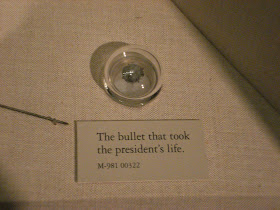
My grandparents had hoped my uncle would grow up to be a doctor. My grandfather was a doctor, and both of my grandmother's brothers as well as her father were doctors. So it was perhaps only natural that they would expect their only son to follow in the family business and heal the sick.
With these high hopes -- or so goes the family lore -- they paid a visit to a museum of medical oddities when my uncle was still a young and impressionable boy. My grandfather had hoped that the array of weird things floating in jars would pique the boy's interest. Instead, my uncle was so horrified by the entire experience that he swore he'd never become a doctor. He still recalls the experience with disgust and horror.
So it was with great excitement and not a small amount of trepidation that I agreed to visit the National Museum of Health and Medicine, located at Walter Reed Army Medical Center. I had heard that this museum had the bullet the killed Lincoln, fetuses in jars, and medical oddities of all kinds including the world's biggest hairball. I'm fairly squeamish, so while I was really intrigued, it wasn't out of the question that I might pass out on the premises.

Well, I remained conscious although there were a couple things that turned my stomach (especially the leprosy pictures and the leeches). Mostly though, the museum focuses on military medical history starting with the Civil War through the current conflict in Iraq. In particular, it chronicles the advances of caring for the war wounded, improvements in field hospitals and ways to identify those who died during war. There is also an extensive exhibit on the evolution of the microscope -- from Anton van Leeuwenhoek (hello seventh grade science!!) to modern electron microscopes.

But it's not all tame and historical. There is some weird, gross and even funny stuff in the collection too.
Take, for example, the world's biggest hairball. It was removed from the stomach of a 12 year old girl who had been eating her hair for six years and it was the exact shape of her stomach. Eww!

Or how about the preserved tongue and esophagus of someone who died while choking -- it's floating in formaldehyde along with the enormous piece of steak that the person died trying to eat.
Cross sections of lungs taken from coal miners (pitch black), iron minors (dark red), smokers (gray with white cancer) and city dwellers (distressingly, alarmingly nearly as gray as the smokers' lungs).

There was also an exhibit on misguided medical equipment, including an x-ray machine that x-ray'ed people's feet in their shoes at the shoe store to ensure that they fit properly. We watched a rather charming video about the machine in which we learned that these machines emitted 25 rems per minute in order to ensure that your shoes fit properly (recommended radiation exposure for nuclear power plant employees is not to exceed 5 rems per year!). About 20 years later, when shoe salesmen started dying of cancer left and right, the machines declined in popularity.

There is a lot to see at this museum -- it's free, and easily accessible from the 70 bus. You will need to show your ID in order to get onto the property though. If you like history, military history, science, medical facts or just really gross/weird stuff, you've got to go. I imagine that young boys might especially like this museum -- unless you're trying to initiate them into a medical career-- then it might backfire. Just ask my uncle.

No comments:
Post a Comment